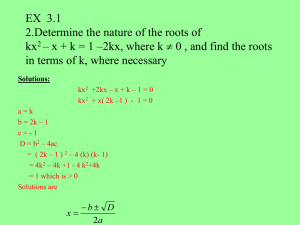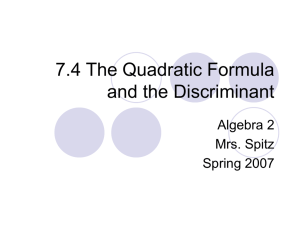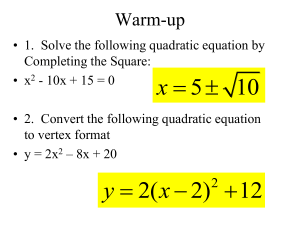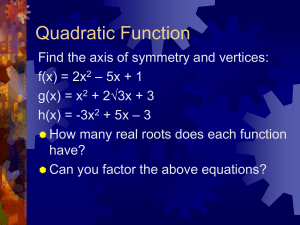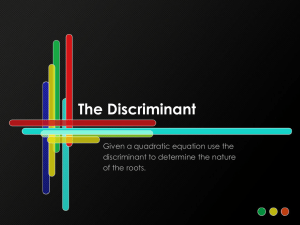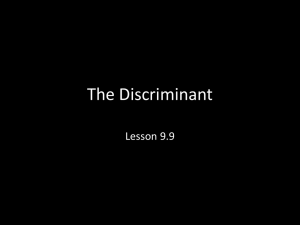Discriminant - Camden Central School
advertisement
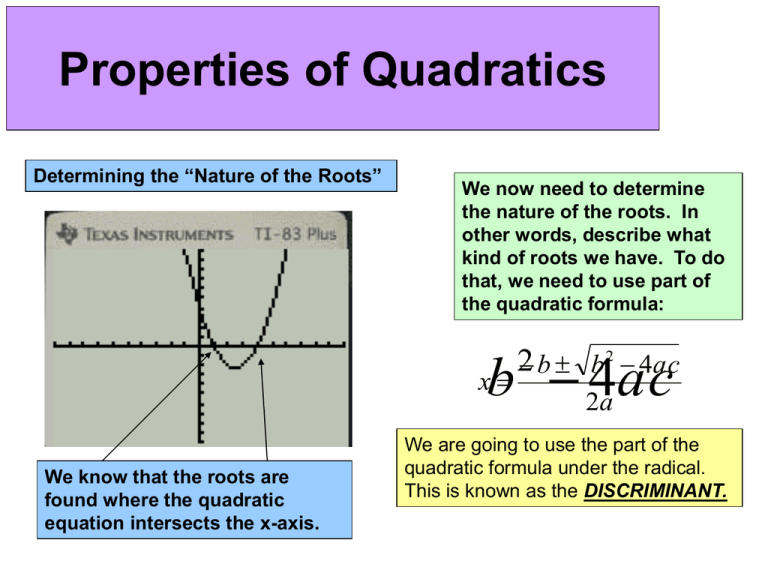
Properties of Quadratics Determining the “Nature of the Roots” We now need to determine the nature of the roots. In other words, describe what kind of roots we have. To do that, we need to use part of the quadratic formula: b 24a ac x We know that the roots are found where the quadratic equation intersects the x-axis. 2 b b2 4ac We are going to use the part of the quadratic formula under the radical. This is known as the DISCRIMINANT. Using the discriminant: b 4ac 2 There are three things we need to check for: 1. Real vs. Imaginary 2. Equal vs. Unequal 3. Rational vs. Irrational Lets check the four cases: Case 1: Discriminant is negative: b 2 4ac 0 This means that the roots are imaginary because we have a negative under the radical. Case 2: Discriminant is zero: b 2 4ac 0 This means that the roots are real, equal and rational. EX: Suppose the formula gave us the following: 3 0 x 6 3 0 3 1 30 3 1 x x 6 6 2 6 6 2 So we see that both roots are ½, so they are equal, and ½ is a real, rational number! Case 3: Discriminant is positive and a perfect square: b 2 4ac 0 Case 4: Discriminant is positive and not a perfect square: b 2 4ac 0 This means that the roots are real, unequal and rational. This means that the roots are real, unequal and irrational. EX: Suppose the formula gave us the following: EX: Suppose the formula gave us the following: 1 9 x 2 1 3 4 x 2 2 2 1 17 x 2 1 17 x 2 1 3 2 x 1 2 2 1 17 x 2 So we see that both roots real, rational numbers that are NOT equal So we see that both roots real, irrational numbers that are NOT equal Summary: 1. b 4ac 0 Discriminant is negative so roots are imaginary. ONLY TIME THAT THE ROOTS ARE IMAGINARY! 3. b 2 4ac 0 Discriminant is a positive perfect square so roots are real, rational and unequal. 2. b 2 4ac 0 Discriminant is zero so roots are real, rational and equal. ONLY TIME THAT THE ROOTS ARE EQUAL! 4. b 2 4ac 0 Discriminant is a positive non-perfect square so roots are real, irrational and unequal. ONLY TIME THE ROOTS ARE IRRATIONAL! 2 Page 1 #1: x 2 5x 4 0 a 1 b 5 c 4 b 2 4ac 52 41 4 41 The discriminant is a positive, non-perfect square. Therefore the roots are: 1. Real 2. Irrational 3. Unequal #2: x 2 8 x 20 0 a 1 b 2 4ac b 8 c 20 82 41 20 144 The discriminant is a positive, perfect square. Therefore the roots are: 1. Real 2. Rational 3. Unequal Page 1 #5: 4 x 2 12x 9 0 a4 b 12 c9 b 2 4ac 122 449 0 The discriminant is zero. Therefore the roots are: 1. Real 2. Rational 3. Equal 2x2 6x 5 6x 5 6x 5 #7: 2x2 6x 5 0 a2 b 6 c5 b 2 4ac 62 425 4 The discriminant is negative. Therefore the roots are: 1. Imaginary Page 1 #8: 3x 2 5 x 0 a3 b 5 c0 b 2 4ac 52 430 25 The discriminant is a positive, perfect square. Therefore the roots are: 1. Real 2. Rational 3. Unequal x2 4x 3 4x 3 4x 3 #22: x2 4x 3 0 a 1 b 4 c 3 b 2 4ac 42 41 3 28 The discriminant is a positive, non-perfect square. Therefore the roots are: 1. Real 2. Irrational 3. Unequal Homework •Page 1 #3,6,9,11,13,15,17,19, 21,24,27,30,33

